
-
Snell`s Window: 3D animation by Mikkel Strøbech...
-
Bill Bryden from Newfoundland on advice and practical details that help you hook up with salmon and trout on a dry fly
Sudden appearance
We, as anglers, can benefit from the knowledge of Snell`s Widow and place the fly as close to the window as possible. The sudden appearance of the fly in the area of decision may often be followed by an immediate strike… The edge or rim of Snell`s Window seems to be a hot area to put a fly – something worth calling to mind next time you see a salmon or trout on the river bed or visit a place where you usually would expect to find them.
Fishmadman angler Per Fischer precisely positioned the dry fly in Snell`s Window – on Atlantic salmon lying in shallow water. At this spot, the cone of Snell`s Window is tiny
 Get into the groove!
Get into the groove!
Salmon dry fly pioneer: George M.L. La Branche wrote in his book The Salmon And The Dry Fly (1924) about his observations and thoughts on where in the river to hook up with dry fly salmon.
La Branche saw the salmon pools with the eye of a trout fisherman and advocated that the angler should seek out places in the river that would be similar to the area where the resident trout would take a position to intercept the flow of food. He named these places where the current would deliver the insects: grooves and was sure that one would only connect with salmon if one could accurately cast the fly in these grooves.
Years of fishing have shown me and other anglers that it is not merely down to a perfect cast to Snell’s Window ... to hook up with salmon on a dry fly – The salmon is not online all the time – as I would like to explain it.
Sometimes he will rise to a well-presented dry fly within a few casts – another day, he might rise unexpectedly to the fly presented in Snell`s Window the 50`th times…with the attitude of a starved trout rushing for the only meal of the day.
Read more about La Branche and his ideas and fishing here
Pushing the fly in Snell`s Window
Rarely caught on film – The take of an Atlantic salmon on a dry fly – I was lucky to get it in the box last season and am happy to show you this particular video concerning our newsletter on Snell`s Window… The salmon in the film does not bite over the fly – it merely pushes the fly. You will see the fly surfing in front of the fish. Many of the dry fly caught I had this summer was hooked on the nose or forehead, as seen on some of the pictures in the slide section: Why? – Can`t tell you…some years, they work like that .. the spot I film: 3-foot leader out of guides…Wham!
What do fish see?
How do salmon and trout detect and see things underwater and in Snell`s Window? As regular anglers, we know very little about this. We often look at the roaring river and wonder if the fish will have any chance of seeing a tiny fly on the surface – Salmon and trout have no problems detecting prey sitting or moving on the surface; they have trained these skills for 100 million years and have become true experts.
Things like: contrast, light and colours will probably reveal the insect to the fish, and it will gather this information in its tiny brain and decide if it wants to move for the prey.
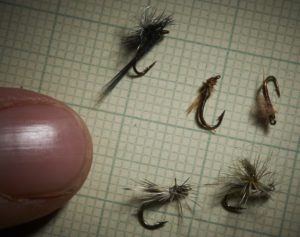
Salmon and trout have no problems detecting prey on the surface; they have trained these skills for 100 ↑ million years. Here absurdly small dry flies and flymf’s tied for selective trout in the Montana River system
 Back to Basics with guide Bill Bryden
Back to Basics with guide Bill Bryden
It has been said that dry fly Atlantic salmon fishing is the pinnacle of freshwater fly fishing. The shocks and warm rushes of adrenaline it provides are not easily had in any other form of fishing. The skill and patience required often prove too much for even seasoned fly anglers, but the rewards are truly breathtaking for those who persevere. I hope that some of this discourse will encourage those who have not tried this pursuit to pick up the torch while also helping to enlighten the way for those stumbling on the first hurdles. Perhaps even the most advanced dry fly salmon angling masters may find a morsel in these pages, as may the trout purist.
Stealth & Accuracy
We could summon it up this way: Leaders are part of the presentation, and one wants to present the fly with stealth and accuracy, especially near Snell`s Window – A leader that can transform the movement from the fly line to the fly is important.
 Correcting the fly – and Snell’s Window.
Correcting the fly – and Snell’s Window.
Novice anglers can accomplish fundamental wet fly presentations by correcting a presentation after the fly lands. Similarly, correcting an inaccurately positioned dry fly can be done by dragging it to the exact inch it needs to be on to allow for the correct drift into Snell`s Window. However, this dragging of the fly must be done very slowly and ideally outside of Snell’s Window except in particular circumstances. Once the fly is near Snell’s Window, no quick movements should be done when attempting to coax a salmon from its lair. We d not want to convince our quarry that the fly could move quickly and thus escape any attempt it may make to capture it. We want to make a nice easy target.
Fish are experts at being fish.
Fish rarely “miss” anything they genuinely want to eat. Often they inspect a dry fly several times before committing to taking it into their mouth, engage further by closing their mouth completely, and finally abandon all worry while holding it for submersion to their lay. This bodes well for the dry fly neophyte as the most solid take is often the second to fourth rise when the adrenaline has the angler cocked and ready like a rattlesnake.
Accuracy required
The roughly 45-degree angle from the fish to the edge of Snell’s Window makes it relatively easy to work out where the edge of Snell’s Window is situated. For example, at a water depth of 6 feet, the edge is 6 feet upstream of where the fish is lying. One always wants to ensure one’s leader is long enough to keep the end of the fly line out of Snell`s Window, so fishing deep lays requires longer leaders.
Once some skill in casting accuracy is acquired, the first target is the edge of Snell’s window. Even in the rippled water, many salmon hide under, the fish will see larger dry flies travelling through the air and land precisely in their drift line for feeding. This is why many Newfoundland dry fly anglers make lazy, gentle casts. The fly is cast to have it flying along very close to the surface once in Snell’s window. Most Newfoundland dry fly anglers use an underpowered, slightly sidearm cast, with the fly within a foot or two or the surface for its entire travel within Snell’s window.
 Keep Pushing the button.
Keep Pushing the button.
This is the bog-standard approach for dry fly angling and has the best chance of working on all fish in any condition. Patience is the name of the game, and 20 minutes is not too long to work a fish. Imagine regularly catching a salmon every 20 minutes. The dry fly salmon angler often catches more salmon than a wet fly angler (by far).
Positioning the fly with accuracy near Snell’s Window – a bit like playing with a string in the dart-arrowConsistency
If casting accurately is the most critical part of dry fly fishing for Atlantic salmon, then consistency is the second.
Often, in deep water with variable current speeds between the river bottom and the surface, a lazy relaxed salmon will rise towards Snell’s Window before the fly even touches the surface. Consistently timed presentations accomplish this. If an angler convinces a salmon that a hatch has started by repeated casting, they have a much better chance of inducing a feeding response. Timing the presentations consistently will allow fish to get excited about anticipating the next offering. Those inlays with faster surface currents must rise up closer to the surface and stay suspended or use their tail power to reach the fast-moving target in Snell`s Window. This is because the water speed they are lying in is not enough to naturally lift them to the surface by using only their pectoral fins. An angle that presents their dry fly consistently will take more of these fish than one that makes inconsistently timed casts. This can be observed in clear rivers with fish laying in the slack water behind ledges, rocks, and quickly deepening pools.
Often, these two reasons, accuracy and consistency, hamper the beginner’s effort.
Low water on the Majestic Repparfjord River in the far North of Norway, 1000’s of opportunity on Snell’s Window waits below.
Delivery to the door
Lazy fish such as stale fish, large fish, and those in warm water will want the fly to drift to where the current will naturally lift them without any sideways body movement or trusting from their tail. They will want to bob up like a waterlogged deadhead to take the fly with a lazy head and tail rise in Snell’s Window. With this approach of super-accurate casting and perfectly lined-up dead drifting, the angler tries to induce a natural, relaxed feeding response.
Tight lines Bill Bryden: To contact Bill Bryden, Click here.


 Get into the groove!
Get into the groove!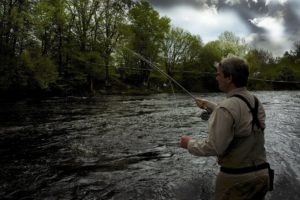 Back to Basics with guide Bill Bryden
Back to Basics with guide Bill Bryden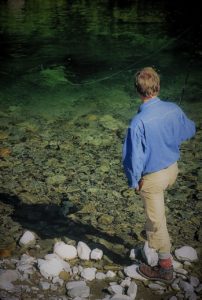 Correcting the fly – and Snell’s Window.
Correcting the fly – and Snell’s Window.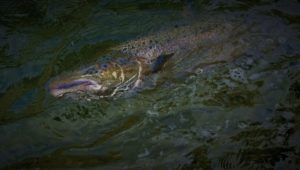
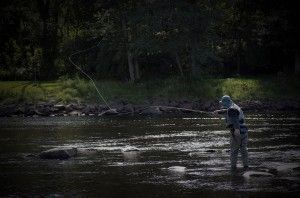 Keep Pushing the button.
Keep Pushing the button.